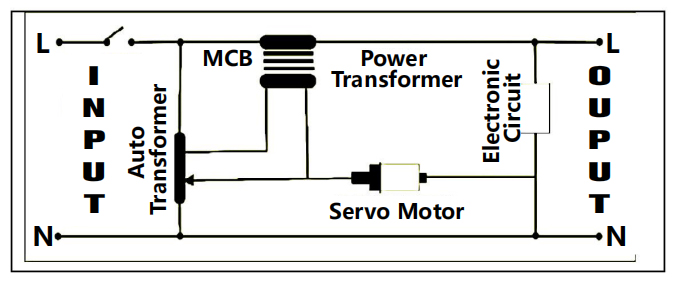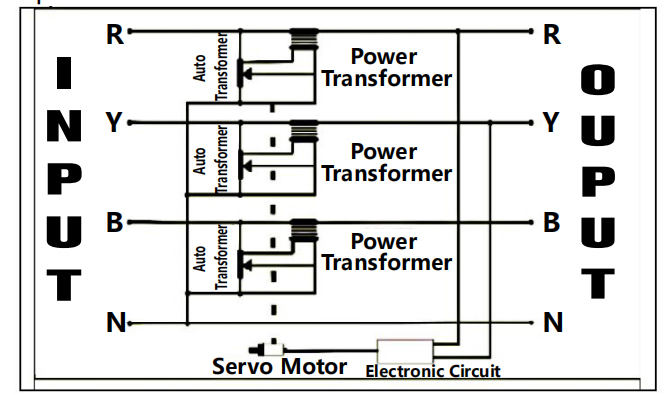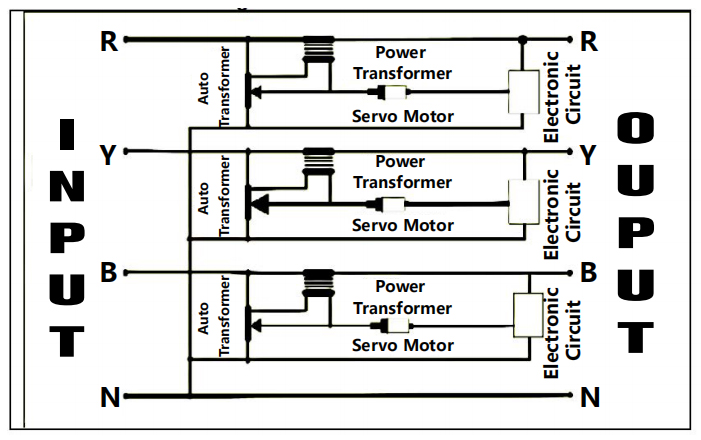Servo Stabilizers uses an advanced electronic servo-motor concept to control a motorized variable transformer. Because of the motorization, there is a small delay in voltage correction. However, output voltage accuracy is usually ± 1% with input voltage changes up to ± 50%. These machines are not affected unduly by power factor or frequency variation. This type of technology tends to be extremely effective when considering large three-phase applications, as it is able to maintain its accuracy of all three phases, both line to line and line to neutral, irrespective of input voltage balance and load balance at any power factor. They are also able to withstand large inrush currents, normally experienced with inductive loads. Single-phase stabilizers and three-phase stabilizers are available in our company, providing higher performance and more reliability. What are the differences between them?
Single Phase Voltage Stabilizer
The control circuit of this type of single-phase voltage stabilizer (12 kVA-50 kVA) continuously monitors the output voltage and looks for any error in the output. Any deviation in the output is immediately corrected by switching on the Servomotor. The motor coupled to the variable autotransformer increases/decreases the voltage to primary of buck/boost transformer. The buck/boost transformer adds/subtracts the voltage to mains so that the output remains within the set limits.

Three Phase Voltage Stabilizer (Balanced Load)
This three-phase voltage stabilizer (3 kVA-20 kVA) employs a single control circuit. The three varieties are mechanically coupled driven by a single motor. Sensing is done phase to phase and the correction is done accordingly. This is suitable for use with a balanced supply and a balanced load. Sone unbalance in load/supply can be tolerated but at a loss of accuracy in the output voltage.

Three Phase Voltage Stabilizer (Unbalanced Load)
This type of AC voltage stabilizer is more versatile and is the most commonly used type, for use with three-phase/single-phase machines/loads. The basically consists of 3 single-phase units of 1/3 capacity each, connected in ‘STAR’. In this type, the output voltage on all three phases is balanced even if the input voltage and the loads connected on the three phases are entirely different (unbalanced). This uses three motors along with three variants and three solid-state control circuits.

Advantages of 1-phase & 3-phase Voltage Stabilizer
- Corrects voltage automatically and continuously.
- Induction motors operate at high efficiency and improve power factor when supplied with constant voltage
- Protects costly manufacturing equipment from the menace of High/Low Voltages, thus cutting on the maintenance cos fewer Production losses & better efficiency in the plant.
- Increased productivity.
- 100% depreciation from Income Tax.
- Reduces MDI and saves power.
- Reduction in electricity bills up to the level of approximately 155 (This also depends on the input variation, loading and the number of working hours)
- Saves diesel cost, as the generator is not required to run at high/low input voltages.
- The average payback period of servo controlled voltage stabilizer owing to its high energy saving capability is approx.. 18 months.
